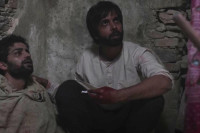Movies
Focusing on what if rather than what was
Subash Thebe Limbu’s debut film ‘Ningwasum’ shows the limitless possibilities for experimentation in the craft.
Pinki Sris Rana
The room is draped in black cloth, and in the middle of it are two life-size mannequins hanging horizontally in the air, appearing as if they are reaching out for one another. Cladded from top to bottom in white—from white motorcycle helmets, white space jumpsuit, white gloves to white lace-up boots, the mannequins appear like two astronauts floating in the night sky.
This room is where ‘Ningwasum’ is being screened. Given the movie’s subject matter, the props in the room make sense.
The film was first screened for the Nepali public on February 11 at Nepal Art Council, as part of this year’s Kathmandu Triennale, an international art festival based in Kathmandu. But long before the screening, the film had already managed to create an online buzz. After all, ‘Ningwasum’ was Nepal’s first sci-fi film in almost six years. The film first premiered at the Asia-Pacific Triennial Queensland Art Gallery and the Gallery of Modern Art in Brisbane, both in Australia.
From the moment the sci-fi film’s trailer appeared on social media, it managed to grab people’s attention since Nepal rarely sees films of this genre. The last time Nepal saw locally produced sci-fi films was in 2016 when Bijuli Machine, a feature-length sci-fi movie, and Tales of Time-Axis, a short sci-fi film, were released.
The film’s story is set in the future where humanity has cracked the code of time travel. As the film starts, we are greeted by the main character Miksam who from the future time travels to the present in order to find her father. The film is set in Yakthung, a futuristic Limbu nation, and the only two recurring characters that we see are Miksam, played by Subin Limbu, and Mingsoma, played by Shanta Nepali. Throughout the film, the two characters are seen wearing white space suits, the same kind worn by the mannequins in the screening room. Miksam also wears a bulaki, a traditional gold nose ring commonly worn by women from indigenous communities.
The first half of the film is set in the world Miksam comes back to, and it is through Miksam’s monologues, we understand the changes the world has undergone to become what it is in the future. The second half of the film introduces viewers to Mingsoma. The two characters only converse with each other telepathically in the Yakthung language, which many viewers might not be familiar with and thus rely on the English subtitles.
And this is where the film becomes difficult to understand. Since both the actors' voices sound very similar, in some scenes, it is difficult to differentiate the speaker from the listener.
“I did think about using different subtitle colours for the two characters, but then I decided not to because I thought doing so would be like feeding everything to the audience,” says Subash Thebe Limbu, the film’s director.
‘Ningwasum’ is a slow-paced film, and its runtime of 40 minutes is divided into several chapters that attempt to reveal the Yakthung community’s tradition and culture. But those unfamiliar with the community can find it challenging to fully grasp the culture's intricacies.
From the choice of genre to the use of Yakthung language and folk music with contemporary and grave topics like Adivasi Futurism, ‘Ningwasum’ sets the bar high for Nepali filmmakers looking to experiment with their craft.
“I didn't make the movie to make money out of it. It was simply an effort to explore an art form beyond what we have heard from the past or what we see at present,” says Subash. “To take such a risk, one cannot afford to dwell on what the audience might think and whether the film would be too complex for them to understand.”
While 'Ningwasum' may be Subash's debut film, he has been involved in various art forms in the last ten years. The 41-year-old has spent considerable time making music, painting, and doing various performing arts while working a part-time job to sustain his life in the UK.
But what sets his debut film apart is how Subash has not held back from experimenting and exploring concepts like Adivasi Futurism. This speaks volumes about his faith in his craft.
Similar to Afrofuturism, loosely understood as an artistic, social, and political movement that envisions a fantasy world that explores black history and culture, Adivasi Futurism bases its works on the perspective and experiences of the indigenous communities. In ‘Ningwasum’, Subash has created a fantasy world based entirely on the Yakthung community.
Centring the narrative around Adivasi Futurism, the film touches upon oppression by Brahmanical patriarchy, forced displacement of indigenous communities, language politics, climate change, sustainability, colonialism, and capitalism. Watching the film, one cannot help but feel as if Subash is using the film as a platform to share his personal feelings and lived experiences.
"An American writer called Walidah Imarisha once said, ‘We can’t build what we can’t imagine’,” says Subash. “‘Ningwasum’ isn’t just limited to critiquing the current societal status quo, but it is also about moving further from realism and having the liberty to imagine a future that we can aspire towards."
Subash also plans to host a special screening for members of the indigenous communities and collaborate with such communities to come up with their own futuristic stories.
'Ningwasum' is not the easiest film to understand, but do not let this aspect dissuade you from watching it. At its best, the film shows the limitless possibilities for experimentation in the craft, and Subash deserves all the credit for being brave enough in pushing the envelope.




 17.12°C Kathmandu
17.12°C Kathmandu










